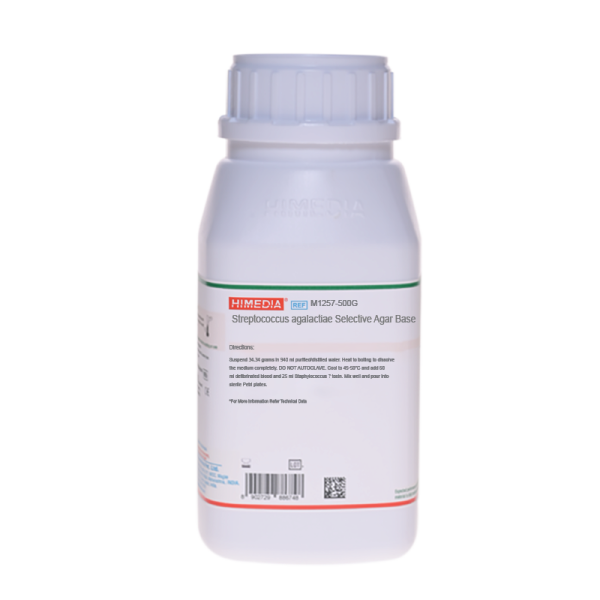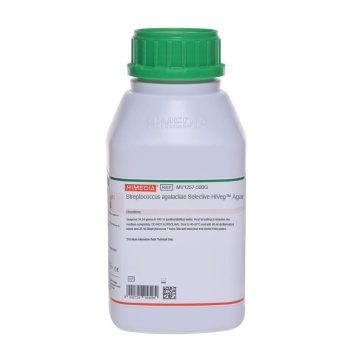 Your enquiry has been submitted
Your enquiry has been submitted
Streptococcus agalactiae Selective Agar Base
Streptococcus agalactiae#CC293D
Intended Use
Recommended for selective isolation of Streptococcus agalactiae from dairy products.
Composition**
| Ingredients | g/L |
|---|---|
| Peptone | 10.000 |
| HM extract # | 5.000 |
| Sodium chloride | 5.000 |
| Esculin | 1.000 |
| Thallous sulphate | 0.333 |
| Crystal violet | 0.0013 |
| Agar | 13.000 |
Final pH (at 25°C): 7.4±0.2
**Formula adjusted, standardized to suit performance parameters
# Equivalent to Meat extract
Directions
Suspend 34.34 grams in 940 ml purified / distilled water. Heat to boiling to dissolve the medium completely. DO NOT AUTOCLAVE. Cool to 45-50°C and add 60 ml defibrinated blood and 25 ml Staphylococcus β toxin. Mix well and pour into sterile Petri plates.
Principle And Interpretation
Streptococcus agalactiae is a gram-positive Streptococcus characterized by the presence of group B Lancefield antigen. S. agalactiae exhibits beta haemolysic reaction. On Blood agar plate, it forms zones of haemolysis that are slightly bigger than the size of colonies formed. Group B streptococci hydrolyze sodium hippurate and give a positive response in the CAMP test. S. agalactiae is also sensitive to bile and will lyse in its presence. Streptococcus Agalactiae Selective Agar was formulated by Hauge and Kohler-Ellingsen (1) for the isolation of S. agalactiae, the causative agent of mastitis in cattle. Differentiation between Streptococcus species is done on the basis of esculin hydrolysis seen as dark brown colour due to formation of an esculin-thallium complex. Thallous sulphate and crystal violet inhibit the accompanying bacterial flora. Staphylococcus β-toxin attacks the erythrocytes present in the medium in such a way that they may be completely haemolyzed. S. agalactiae is not haemolytic on simple blood agar. Thus S.agalactiae can be distinguished from obligate, non-haemolyzing colonies.Peptone and HM extract serves as a source of nitrogeneous and carbonaceous compounds, long chain amino acids, vitamins and other essential growth nutrients. S. agalactiae forms dove-blue coloured smooth colonies surrounded by zones of haemolysis. Further identification is done by using biochemical and serological methods, but primarily by using CAMP test (2).
Type of specimen
Dairy samples
Specimen Collection and Handling
For dairy samples, follow appropriate techniques for sample collection and processing as per guidelines (3,4). After use, contaminated materials must be sterilized by autoclaving before discarding.
Warning and Precautions
Read the label before opening the container. Wear protective gloves/protective clothing/eye protection/ face protection. Follow good microbiological lab practices while handling specimens and culture. Standard precautions as per established guidelines should be followed while handling specimens. Safety guidelines may be referred in individual safety data sheets.
Limitations
- Further identification is done by using biochemical and serological methods, but primarily by using CAMP test (2).
Performance and Evaluation
Performance of the medium is expected when used as per the direction on the label within the expiry period when stored at recommended temperature.
Quality Control
Appearance Cream to yellow homogeneous free flowing powder
Gelling Firm, comparable with 1.3% Agar gel.
Colour and Clarity of prepared medium Basal medium forms light purple coloured, clear to slightly opalescent gel. On addition of blood, red coloured opalescent gel forms in Petri plates
Reaction Reaction of 3.43% w/v aqueous solution at 25°C. pH : 7.4±0.2
pH 7.20-7.60
Cultural Response Cultural characteristics observed after an incubation at 35-37°C for 24-48 hours.
| Organism | Inoculum (CFU) | Growth | Recovery | Blue colony | Haemolysis |
|---|---|---|---|---|---|
| Escherichia coli ATCC 25922 (00013*) | >=104 | inhibited | 0% | ||
| Enterococcus faecalis ATCC 29212 (00087*) | 50-100 | good-luxuriant | >=50% | variable reaction | alpha |
| Pseudomonas aeruginosa ATCC 27853 (00025*) | >=104 | inhibited | 0% | ||
| Staphylococcus aureus subsp. aureus ATCC 25923 (00034*) | >=104 | inhibited | 0% | ||
| Streptococcus agalactiae ATCC 13813 | 50-100 | luxuriant | >=50% | positive | beta |
| Streptococcus agalactiae ATCC 27956 | 50-100 | luxuriant | >=50% | positive | beta |
| Streptococcus cremoris ATCC 19257 | 50-100 | luxuriant | >=50% | variable reaction | alpha |
| Streptococcus pneumoniae ATCC 6301 | 50-100 | luxuriant | >=50% | negative | alpha |
| Streptococcus pyogenes ATCCC 19615 | 50-100 | luxuriant | >=50% | negative | beta |
| Streptococcus lactis ATCC 19435 (00016*) | >=104 | inhibited | 0% |
Key: *Corresponding WDCM numbers.
Storage and Shelf Life
Store between 10-30°C in a tightly closed container and the prepared medium at 2-8°C. Use before expiry date on the label. On opening, product should be properly stored dry, after tightly capping the bottle in order to prevent lump formation due to the hygroscopic nature of the product. Improper storage of the product may lead to lump formation. Store in dry ventilated area protected from extremes of temperature and sources of ignition. Seal the container tightly after use. Product performance is best if used within stated expiry period.
Disposal
User must ensure safe disposal by autoclaving and/or incineration of used or unusable preparations of this product. Follow established laboratory procedures in disposing of infectious materials and material that comes into contact with sample must be decontaminated and disposed of in accordance with current laboratory techniques (5,6).
Reference
- Hauge S. T. and u Kohler-Ellingsen J., 1953, Nord. Vet. Med., 5:539.
- Christie R., Atkins N. E. and Munch-Petersen E., 1944, Aust. J. Exp. Biol. Med. Sci., 22:197.
- American Public Health Association, Standard Methods for the Examination of Dairy Products, 1978, 14th Ed., Washington D.C.
- Wehr H. M. and Frank J. H., 2004, Standard Methods for the Microbiological Examination of Dairy Products, 17th Ed., APHA Inc., Washington, D.C.
- Isenberg, H.D. Clinical Microbiology Procedures Handbook 2nd Edition.
- Jorgensen, J.H., Pfaller, M.A., Carroll, K.C., Funke, G., Landry, M.L., Richter, S.S and Warnock., D.W. (2015) Manual of Clinical Microbiology, 11th Edition. Vol. 1.
| Product Name | Streptococcus agalactiae Selective Agar Base |
|---|---|
| SKU | M1257 |
| Product Type | Regular |
| Physical Form | Powder |
| Origin | Animal |
| Packaging type | HDPE |
| References | 1. Hauge S. T. and u Kohler-Ellingsen J., 1953, Nord. Vet. Med., 5:539. |
| Customized Product Available | No |








